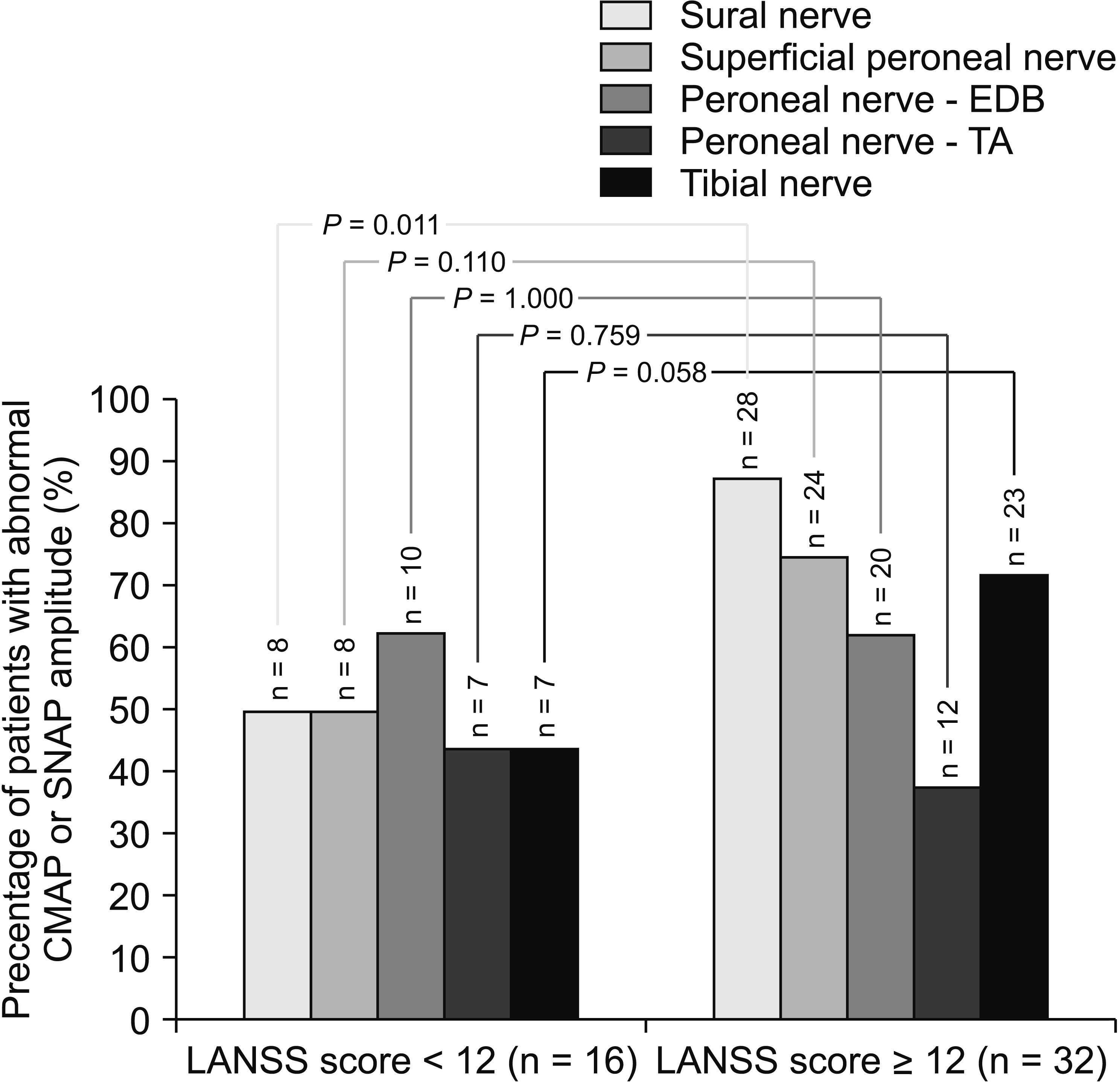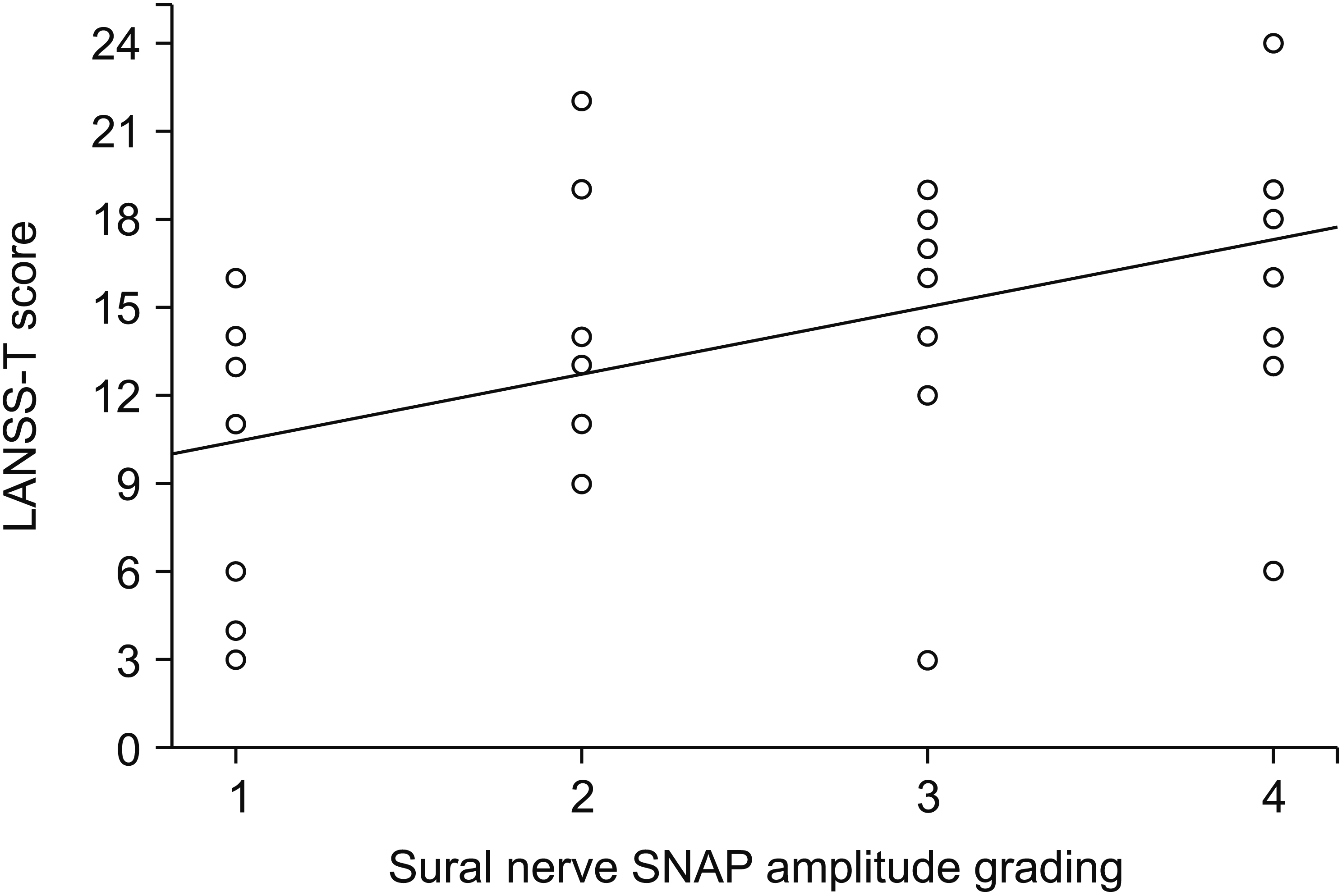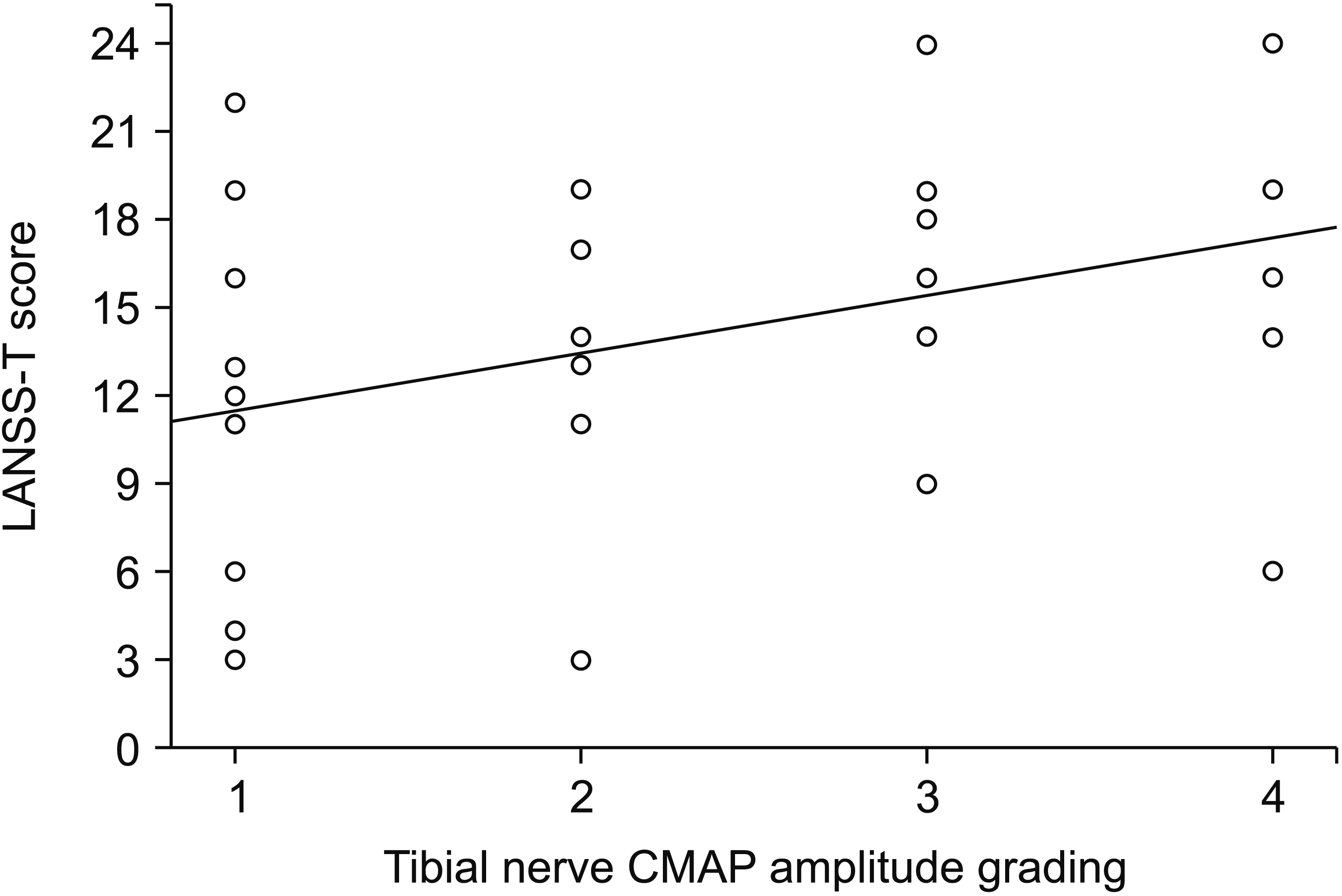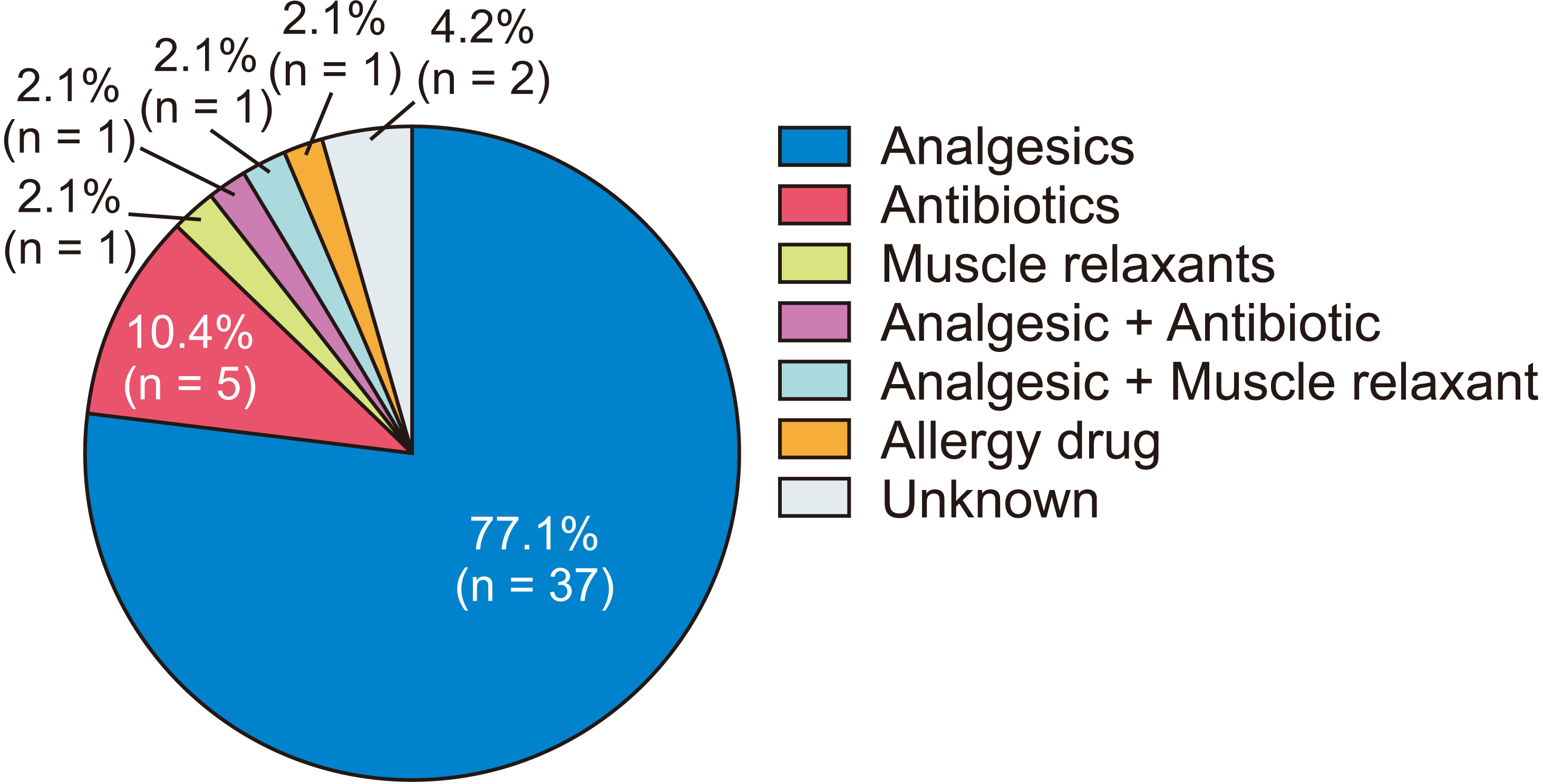2. Yuen EC, So YT, Olney RK. 1995; The electrophysiologic features of sciatic neuropathy in 100 patients. Muscle Nerve. 18:414–20. DOI:
10.1002/mus.880180408. PMID:
7715627.

3. Tak SR, Dar GN, Halwai MA, Mir MR. 2008; Post-injection nerve injuries in Kashmir: a menace overlooked. J Res Med Sci. 13:244–7.
5. Yucel A, Senocak M, Kocasoy Orhan E, Cimen A, Ertas M. 2004; Results of the Leeds assessment of neuropathic symptoms and signs pain scale in Turkey: a validation study. J Pain. 5:427–32. DOI:
10.1016/j.jpain.2004.07.001. PMID:
15501424.

6. Fidanci H, Öztürk I, Köylüoğlu AC, Yildiz M, Buturak Ş, Arlier Z. 2020; The needle electromyography findings in the neurophysiological classification of ulnar neuropathy at the elbow. Turk J Med Sci. 50:804–10. DOI:
10.3906/sag-1910-59. PMID:
32222127. PMCID:
PMC7379465.

7. Fidanci H, Öztürk İ, Köylüoğlu AC, Yıldız M, Arlıer Z. 2020; Bilateral nerve conduction studies must be considered in the diagnosis of sciatic nerve injury due to intramuscular injection. Neurol Sci Neurophysiol. 37:94–9. DOI:
10.4103/NSN.NSN_22_20.

8. Senes FM, Campus R, Becchetti F, Catena N. 2009; Sciatic nerve injection palsy in the child: early microsurgical treatment and long-term results. Microsurgery. 29:443–8. DOI:
10.1002/micr.20632. PMID:
19306387.

10. Gentili F, Hudson AR, Hunter D. 1980; Clinical and experimental aspects of injection injuries of peripheral nerves. Can J Neurol Sci. 7:143–51. DOI:
10.1017/S0317167100023520. PMID:
7407720.

11. Yeremeyeva E, Kline DG, Kim DH. 2009; Iatrogenic sciatic nerve injuries at buttock and thigh levels: the Louisiana State University experience review. Neurosurgery. 65(4 Suppl):A63–6. DOI:
10.1227/01.NEU.0000346265.17661.1E. PMID:
19927080.
12. Kline DG, Kim D, Midha R, Harsh C, Tiel R. 1998; Management and results of sciatic nerve injuries: a 24-year experience. J Neurosurg. 89:13–23. DOI:
10.3171/jns.1998.89.1.0013. PMID:
9647167.

13. Lee BH, Won R, Baik EJ, Lee SH, Moon CH. 2000; An animal model of neuropathic pain employing injury to the sciatic nerve branches. Neuroreport. 11:657–61. DOI:
10.1097/00001756-200003200-00002. PMID:
10757496.

14. Bridges D, Thompson SW, Rice AS. 2001; Mechanisms of neuropathic pain. Br J Anaesth. 87:12–26. DOI:
10.1093/bja/87.1.12. PMID:
11460801.

16. England JD, Happel LT, Kline DG, Gamboni F, Thouron CL, Liu ZP, et al. 1996; Sodium channel accumulation in humans with painful neuromas. Neurology. 47:272–6. DOI:
10.1212/WNL.47.1.272. PMID:
8710095.

17. Erichsen HK, Blackburn-Munro G. 2002; Pharmacological characterisation of the spared nerve injury model of neuropathic pain. Pain. 98:151–61. DOI:
10.1016/S0304-3959(02)00039-8. PMID:
12098627.

18. England JD, Gamboni F, Ferguson MA, Levinson SR. 1994; Sodium channels accumulate at the tips of injured axons. Muscle Nerve. 17:593–8. DOI:
10.1002/mus.880170605. PMID:
8196701.

19. Saito T, Yamada T, Hasegawa A, Matsue Y, Emori T, Onishi H, et al. 1992; Recovery functions of common peroneal, posterior tibial and sural nerve somatosensory evoked potentials. Electroencephalogr Clin Neurophysiol. 85:337–44. DOI:
10.1016/0168-5597(92)90138-2. PMID:
1385094.

20. Oteo-Álvaro Á, Marín MT. 2018; Predictive factors of the neuropathic pain in patients with carpal tunnel syndrome and its impact on patient activity. Pain Manag. 8:455–63. DOI:
10.2217/pmt-2018-0045. PMID:
30394186.

21. Katirji MB, Wilbourn AJ. 1988; Common peroneal mononeuropathy: a clinical and electrophysiologic study of 116 lesions. Neurology. 38:1723–8. DOI:
10.1212/WNL.38.11.1723. PMID:
2847078.

23. Truini A, Padua L, Biasiotta A, Caliandro P, Pazzaglia C, Galeotti F, et al. 2009; Differential involvement of A-delta and A-beta fibres in neuropathic pain related to carpal tunnel syndrome. Pain. 145:105–9. DOI:
10.1016/j.pain.2009.05.023. PMID:
19535205.

24. Barraza-Sandoval G, Casanova-Mollá J, Valls-Solé J. 2012; Neurophysiological assessment of painful neuropathies. Expert Rev Neurother. 12:1297–309. DOI:
10.1586/ern.12.93. PMID:
23234392.

25. Oncel C, Bir LS, Sanal E. 2009; The relationship between electrodiagnostic severity and Washington Neuropathic Pain Scale in patients with carpal tunnel syndrome. Agri. 21:146–8. PMID:
20127534.
26. Ortiz-Corredor F, Calambas N, Mendoza-Pulido C, Galeano J, Díaz-Ruíz J, Delgado O. 2011; Factor analysis of carpal tunnel syndrome questionnaire in relation to nerve conduction studies. Clin Neurophysiol. 122:2067–70. DOI:
10.1016/j.clinph.2011.02.030. PMID:
21454124.

27. Gürsoy AE, Kolukısa M, Yıldız GB, Kocaman G, Celebi A, Koçer A. 2013; Relationship between electrodiagnostic severity and neuropathic pain assessed by the LANSS pain scale in carpal tunnel syndrome. Neuropsychiatr Dis Treat. 9:65–71. DOI:
10.2147/NDT.S38513. PMID:
23326196. PMCID:
PMC3544346.

28. Halac G, Topaloglu P, Demir S, Cıkrıkcıoglu MA, Karadeli HH, Ozcan ME, et al. 2015; Ulnar nerve entrapment neuropathy at the elbow: relationship between the electrophysiological findings and neuropathic pain. J Phys Ther Sci. 27:2213–6. DOI:
10.1589/jpts.27.2213. PMID:
26311956. PMCID:
PMC4540851.

29. Sugimoto T, Ichikawa H, Hijiya H, Mitani S, Nakago T. 1993; c-Fos expression by dorsal horn neurons chronically deafferented by peripheral nerve section in response to spared, somatotopically inappropriate nociceptive primary input. Brain Res. 621:161–6. DOI:
10.1016/0006-8993(93)90314-D. PMID:
8221069.

30. Hu P, Bembrick AL, Keay KA, McLachlan EM. 2007; Immune cell involvement in dorsal root ganglia and spinal cord after chronic constriction or transection of the rat sciatic nerve. Brain Behav Immun. 21:599–616. DOI:
10.1016/j.bbi.2006.10.013. PMID:
17187959.

31. Pei BA, Zi JH, Wu LS, Zhang CH, Chen YZ. 2015; Pulsed electrical stimulation protects neurons in the dorsal root and anterior horn of the spinal cord after peripheral nerve injury. Neural Regen Res. 10:1650–5. DOI:
10.4103/1673-5374.167765. PMID:
26692864. PMCID:
PMC4660760.

32. Turco CV, El-Sayes J, Savoie MJ, Fassett HJ, Locke MB, Nelson AJ. 2018; Short- and long-latency afferent inhibition; uses, mechanisms and influencing factors. Brain Stimul. 11:59–74. DOI:
10.1016/j.brs.2017.09.009. PMID:
28964754.

33. Cengiz B, Fidanci H, Kiyak Keçeli Y, Baltaci H, KuruoĞlu R. 2019; Impaired short- and long-latency afferent inhibition in amyotrophic lateral sclerosis. Muscle Nerve. 59:699–704. DOI:
10.1002/mus.26464. PMID:
30847934.

34. Kim SJ, Kim WR, Kim HS, Park HW, Cho YW, Jang SH, et al. 2011; Abnormal spontaneous activities on needle electromyography and their relation with pain behavior and nerve fiber pathology in a rat model of lumbar disc herniation. Spine (Phila Pa 1976). 36:E1562–7. DOI:
10.1097/BRS.0b013e318210aa10. PMID:
21278630.








 PDF
PDF Citation
Citation Print
Print




 XML Download
XML Download